GetEm Jobs is an AI-assisted job application automation platform that streamlines the job search process. It uses smart AI technology to automate applications and find the best job matches efficiently. The platform is designed to save time and reduce stress for job seekers by comparing resumes with job descriptions across top listing sites, providing tailored search results, and automating application submissions.
GetEm Jobs
GetEm Jobs - AI-Powered Job Application Automation

Introduction
Feature
AI-Powered Matching
- Compares resume with job descriptions across top job listing sites
- Provides tailored job search results aligned with skills and experience
- Assigns scores to each job and highlights top scoring phrases
- Helps users quickly determine job fit
Integrated With Job Search Sites
- Works seamlessly with popular job sites
- Automatically fills in job applications with saved user information
Stress-Free Job Hunting
- Requires only a few minutes of daily user input
- Reduces emotional stress of job searching
- Automates tedious parts of job applications
Rapid Application Process
- Accelerates job application process with automated tools
- Allows users to focus on interview preparation
Easy Setup and Use
- Install from Chrome Web Store
- Upload resume
- Set search parameters on job listing site
- Start searching and applying
FAQ
How does GetEm Jobs work?
GetEm Jobs utilizes AI technology to automate job applications and find the best job matches based on your skills and experience.
Is GetEm Jobs free?
GetEm Jobs offers a 10-day trial period, after which users can subscribe to continue using the service.
How do I get started with GetEm Jobs?
To get started, install GetEm Jobs from the Chrome Web Store, upload your resume, set your search parameters on the job listing site, and begin searching and applying for jobs.
Latest Traffic Insights
Monthly Visits
193.90 M
Bounce Rate
56.27%
Pages Per Visit
2.71
Time on Site(s)
115.91
Global Rank
-
Country Rank
-
Recent Visits
Traffic Sources
- Social Media:0.48%
- Paid Referrals:0.55%
- Email:0.15%
- Referrals:12.81%
- Search Engines:16.21%
- Direct:69.81%
Related Websites

TurboLearn AI quickly makes complete notes, interactive flashcards, and custom quizzes from your lectures. Made to help you learn better and remember more, TurboLearn AI changes to fit your specific learning needs. Make the most of your study time today!
292.80 K

Delegate applying to jobs to your assistants or use AI Copilot Applying to jobs can be a tedious and time-consuming task. Delegate this task to your assistants and let them handle the initial application process, including resume submission and cover letter writing. Alternatively, utilize AI Copilot, an innovative tool that can automate the job application process, saving you time and energy. By delegating or automating this task, you can focus on more important things, such as preparing for interviews, networking, and building meaningful connections in your industry. This approach can also increase your chances of getting hired, as your assistants or AI Copilot can help you apply to more job openings, thereby increasing your visibility and reach. Remember, time is valuable, and by delegating or automating the job application process, you can make the most of your time and achieve your career goals more efficiently.
193.90 M

Addlly AI: 1st Complete AI Playground for Content Creation
Addlly AI: 1st Complete AI Playground for Content CreationThe best all-in-one, no-prompt Gen AI Playground for enterprises. Generate SEO blogs, social media posts, ad copy, press releases, newsletters & more.
46.81 K

AI-Powered Speaking Coach for Calls Enhance your communication skills and ace your calls with our innovative AI-driven speaking coach. This cutting-edge technology provides personalized feedback and guidance to help you improve your verbal and non-verbal cues, tone, and language.
AI-Powered Speaking Coach for Calls Enhance your communication skills and ace your calls with our innovative AI-driven speaking coach. This cutting-edge technology provides personalized feedback and guidance to help you improve your verbal and non-verbal cues, tone, and language.Fluently is a personal speaking coach that delivers instant feedback on your day-to-day calls to refine your accent, improve grammar, and expand your vocabulary.
352.33 K



